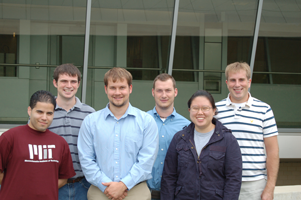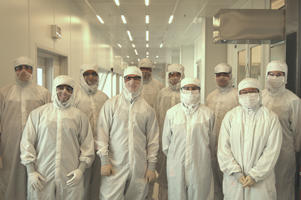More than 120 science, mathematics and engineering college students and recent college graduates were given a chance to ride the next wave in cutting-edge science as part of the 2008 Summer Undergraduate Research Fellowship (SURF) program in Gaithersburg, Md. Supported by the National Institute of Standards and Technology (NIST), the National Science Foundation, and participating colleges and universities, the program provided students with the opportunity to perform meaningful research in state-of-the-art laboratories along with world-class experts.

As a national research agency, NIST gives students access to equipment and materials that cannot be found in typical university settings. For example, one group of students signed on to be a part of NIST's graphene project, an agency-wide effort to produce, characterize, and manufacture devices based on this unique and promising carbon structure.
Resembling a honeycomb or chicken-wire lattice, graphene is the thinnest possible sheet of carbon atoms. When stacked, single-atom thick sheets of graphene become the more familiar graphite found in pencil lead and soot. Graphene combines properties of both semiconductors and metals and conducts electricity more than 100 times faster than silicon. Although graphene shows great promise, scientists have been unable to produce it in the quantities needed for commercial applications or deposit it on a suitable surface ("substrate") with the control necessary to create viable computer chips.
Brian Bolz of Manhattan College looked into systematically controlling the deposition of graphene on a silicon substrate. The present process, called mechanical exfoliation, essentially uses transparent tape to peel graphene from bulk graphite and transfer it to another surface and is uncontrollable. Bolz and his advisor, NIST physicist Nikolai Zhitenev, instead used a silicon substrate with pre-patterned electrodes to zap graphene layers from the bulk graphite and cause them to adhere to the substrate in the places where the field was applied.

Michael Chang of Pennsylvania State University and his advisor, NIST physicist David Newell, focused on the fabrication of a graphene-based device to measure the quantum Hall effect. This quantum phenomenon could yield far more accurate measurements of electrical resistance, but the scarcity of high-quality measurement devices and other factors put access to an accurate electrical resistance standard beyond the reach of most laboratories.
Jonathan Lidga of Cornell University, with his advisor, NIST physicist Joe Stroscio (and fellow SURFer Matt Chang), investigated mechanical exfoliation to produce graphene samples. The team then analyzed those samples with a scanning tunneling microscope to uncover the underlying physics of electrons traveling in graphene.
Paul Fuentes-Martinez focused on characterizing the optical and electrical properties of graphene ribbons. Fuentes-Martinez and NIST materials research engineer Jan Obrzut also experimented with chemical techniques to augment the mechanical exfoliation process and ultracentrifugation to separate the different sizes of graphite flakes and isolate the graphene ribbons.
Tessa Johnson, working with NIST physicists Angela Hight Walker and Jeff Simpson, used a laser-based measurement technique known as Raman spectroscopy to explore the underlying physics of graphene and provide the definitive answer to the other teams whether their efforts to obtain a single graphene layer had been successful.
"The undergraduate research program here was a true research opportunity," Chang said. "Nothing was held back; even as students, we had access to all the cutting-edge technology and were expected to perform side-by-side with full-time NIST scientists. It's astounding to think that we weren't just witnessing but were actually working with Nobel-prize caliber science that in 10-20 years will revolutionize electronics."
The students presented the results of their research in a series of colloquia held during the first week of August and the final week of the SURF program.

